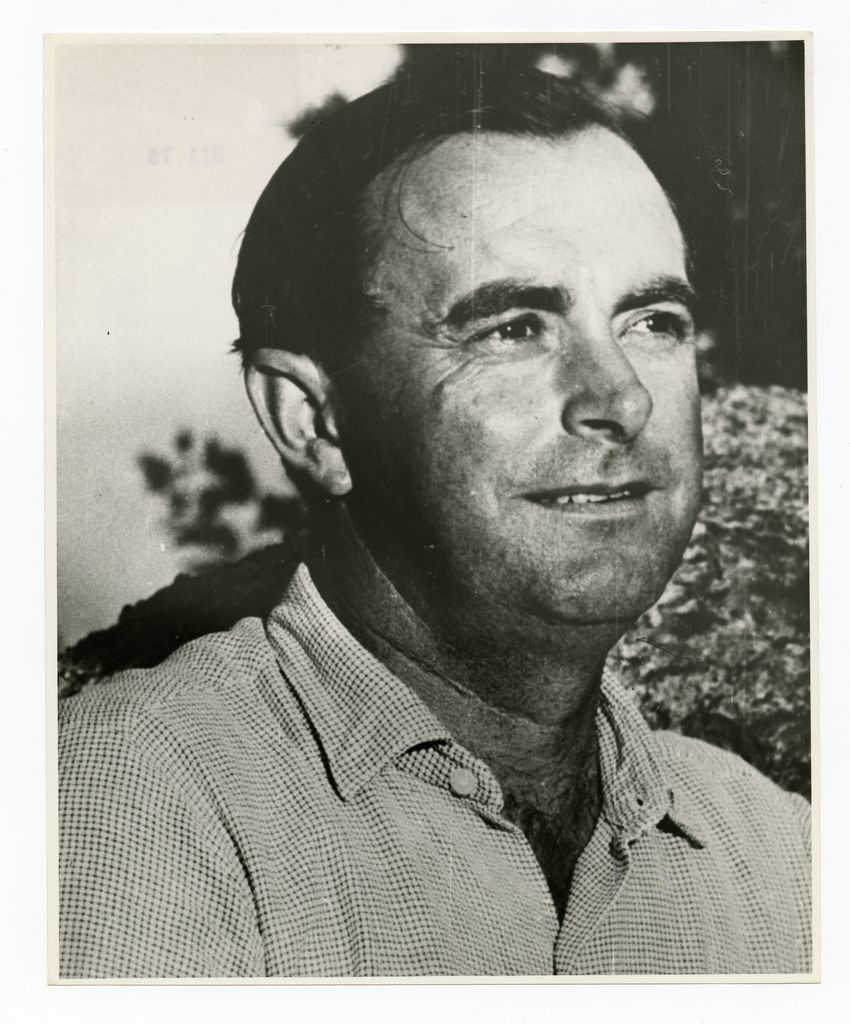 |
| pp. 2-3 "The toughest prey" written by
Douglas Lockwood (bigger version at FB.co.uk) |
 |
| January 1962 (art by Langhammer) |
"There is no more formidable adversary than a monster buffalo" it says on the contents page of Wide World January 1962.The story it refers to is "The Toughest Prey" by Douglas Lockwood
 |
| Contents page |
 |
| Douglas Lockwood From the The University of Queensland, Fryer Library collection |
Any of my Australian readers who fancy visiting the National Library of Australia can access the "Papers of Douglas Lockwood, 1942-1981" Lockwood lived from 1918-1980 and was predominantly a storyteller / journalist. Some of his books on native Australian life and his writings on what he called "the Australian Pearl Harbour" are still in print today. His writings in newspapers can been seen online via the excellent Trove resource which also contains loads of Lockwood's fascinating photographic collection.His biography can be found online, and from it come the following details.
In 1941 Lockwood joined the Melbourne Herald. On 4 October that year at the Methodist Church, Wangaratta, he married Ruth Hay, a clerk. Soon afterwards he was sent to Darwin and in February 1942 saw the first enemy bombs fall on Australian soil. Enlisting in the Australian Imperial Force on 15 June, he trained in intelligence and security duties. He served in New Guinea and on Bougainville in 1944-45 with 'V' and 'Z' Field Security sections, and was promoted warrant officer. Following his discharge on 15 June 1945 in Melbourne, he was a war correspondent for the Herald, reporting from the Netherlands East Indies. In 1946 he returned to Darwin and, except for postings to the Herald's Melbourne (1947-48) and London (1954-56) offices, was to remain there until 1968.
Taken from the Australian Dictionary of Biography
He obviously found the English weather not to his liking and returned home after only 3 years and perhaps encountered this international magazine, Wide World, when here in 1954-1956. Wide World had been going since 1898. My other interest Raymond Sheppard did several pieces for Wide World and therefore I have trawled through quite a few. The tenor of the magazine was always real-life adventures told from all over the world. The earlier editions in the post WWII years have some fantastic covers on them, but interior art was reproduced in such a way to obscure any talent, thus the strange 'cut' photograph-dots look to them. Do a Google search to see images of the covers If you want to read some of the content from the past, try True Adventures for Boys
 |
| p. 5 "The toughest prey" written by
Douglas Lockwood (bigger version at FB.co.uk) |
In the late 50s and early 1960s up to its demise in 1965 more and more photographic materials, in lieu of illustrations, were used in Wide World which I personally found nowhere near as interesting. Contemporaries of Frank Bellamy produced for the magazine too but Bellamy appears to have only produced drawings for one issue.
Douglas Lockwood Bibliography
- Crocodiles and Other People (London, 1959)
- Fair Dinkum (London, 1960)
- I, the Aboriginal (Adelaide, 1962) which won the Adelaide Advertiser's award for literature in 1962 and was later made into a television film We, the Aborigines (Melbourne, 1963)
- The Lizard Eaters (Melbourne, 1964)
- Up the Track (Adelaide, 1964)
- Australia's Pearl Harbour (Melbourne, 1966)
- The Front Door (Adelaide, 1968)
- My Old Mates and I (Adelaide, 1979)
- Northern Territory Sketchbook (Adelaide, 1968)
Co-author:
- Life on the Daly River (London, 1961) with Nancy Polishuk
- The Shady Tree (Adelaide, 1963) with Bill Harney
- Alice on the Line (Adelaide, 1965) with Doris Blackwell
REMEMBER to see these Bellamy pictures in full size follow this link to Frankbellamy.co.uk and click on the 'MORE...' note
The second item Bellamy illustrated is introduced in the same contents page:"Britain's coastguards meet the challenge of unleashed elements"
 |
| p. 20 "Killer wind" written by George Goldsmith Carter |
George Goldsmith Carter Bibliography
- Looming Lights: a true story of the lightships. London : Constable, 1945.
- The Smacksmen. A story of the fishermen of the Borough. London : Constable, 1947.
- Able Seaman. London : Constable, 1948.
- Peter Grimes’ Country, in Lilliput June 1948
- Lights on the Water, in Lilliput April 1949
- Tiger of the Channel, in Lilliput August 1949
- Margaret Catchpole, the Girl from Wolfkettel. London : Constable & Co., 1949.
- Red Charger. A trip to the Arctic fishing grounds. Illustrated by R. P. Bagnall-Oakley. London : Constable, 1950.
- Forgotten Ports of England. London : Evans Bros., 1951.
- The Goodwin Sands. London : Constable and Co Ltd, 1953
- Menace of The Out-Winds (illustrated by Hookway Cowles) in Everybodys August 14 1954
- Death on the Longsand in Lilliput March 1956
- Sailors, sailors (Edited by Derek Lord.) London: Hamlyn, 1966
- Sailing Ships and Sailing Craft (Hamlyn all-colour paperbacks). London: Hamlyn, 1969
- Spotlight on sailing ships (Illustrated by Bill Robertshaw, Angus McBride). London : Hamlyn, 1973.
- The Battle of Britain : the home front. New York : Mason & Lipscomb Publishers, [1974]
- Young Sea-Angler. (with Robert Bateman). London : Constable & Co., [1961]
- A fighting challenge (with John Ridgway; Michael Codd; Chay Blyth) London: Hamlyn, 1969.
Thank you Martin for an enjoyable afternoon doing some research! Your other choices will follow soon!






























